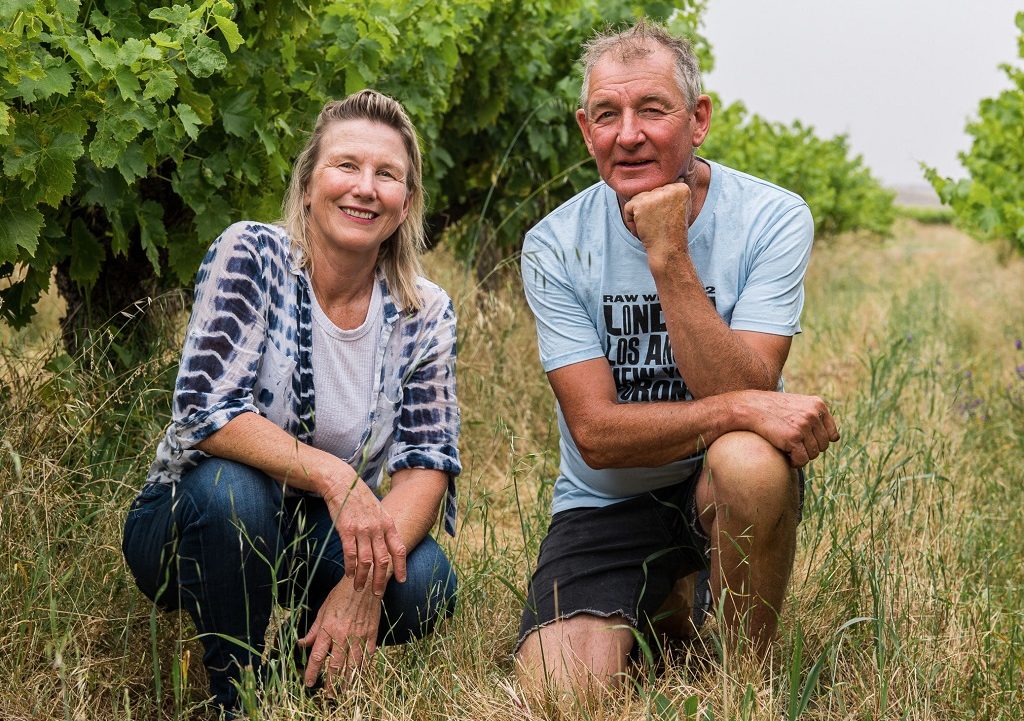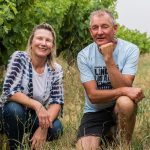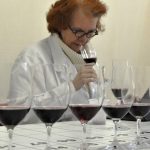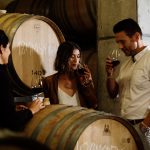Partners in business and life, Smallfry Wines’ Suzi Hilder and Wayne Ahrens.
By Sonya Logan
Smallfry Wines is a partnership in business and life between Suzi Hilder and Wayne Ahrens. Viticulturists bitten by the winemaking bug, the couple acquired a farm in the Barossa Valley which contained an assortment of unidentified varieties including, as they would eventually learn, Trousseau.
When partners in business and life Wayne Ahrens and Suzi Hilder, of small batch producer Smallfry Wines, purchased a farm in Vine Vale, east of the Barossa Valley township of Tanunda, in 2007 they became the custodians of a vineyard that boasted some of the oldest vines in the region. As well as some usual suspects — Grenache, Shiraz, Semillon and Riesling among them — the vineyard contained a “murky hodgepodge” of unidentified vines, as Ahrens describes them.
“I asked Ken, the vendor, what they were and he told me Pinot Noir but I was unsure,” Ahrens recalls. Around 2012, Suzi attended an ampelographers workshop. Ahrens took the opportunity to take samples of the vines along to the workshop where he was informed they were Trousseau — a variety he admits he’d not heard of.
The Trousseau vines in question number little more than 20 vines and are dotted throughout plantings of predominately Grenache and a smattering of Pedro Ximenez, Cinsault and Mataro.
“My theory is that this was a bundle of cuttings that someone picked up from Spain after being told they were Garnacha and were then planted into our Vine Vale dirt,” Ahrens surmises.
Remarking that the Trousseau vines have “butts a foot thick”, Ahrens says cuttings were propagated from these original plantings and used to establish an additional acre “for interest” in 2014.
“We have tended to put the Trousseau on the better sites within the vineyard,” Ahrens says. “We are on Soldized Solondnetz soils which I think does help this variety express in our climate. Budburst is early so we decided to put them on a higher trellis as we are a bit frost sensitive.
“In order for something to be viable on our farm it needs to be resilient. We use a simple foliage catch wire and cordon pruning. There will be no foolish bunch/shoot thinning on our farm.
“We have established a cordon for our young vines and, looking at the old vines, they seem to enjoy the establishment of structure. I am not sure how they would go on cane pruning. In our climate a foliage catch wire is very helpful.”
Asked if the vines were particularly thirsty compared with the other varieties in the vineyard, Ahrens responds saying, “This is an interesting point”.
“Given it is what I would class a continental variety, I think it fits into a similar category as Riesling. Whilst it doesn’t mind a drink (like most of us!) it can do without as well. I don’t see it requiring a higher water regime than we would apply elsewhere. I do think as mangers we need to be aware of the timing of a particular variety’s cycle. As an early variety I include it at the beginning of an irrigation cycle and am aware that a little drink ahead of veraison is going to be ahead of the other varieties on our property.”
He says the variety, or at least his clone of Trousseau, is quite resilient to disease and climatic variations in general.
“They seem quite resilient to fungal disease. In a year when we have had downy mildew pressure in particular they have stood up better than Grenache, for example,” Ahrens notes.
He says yields are “on the low side with small bunches sparsely located”. “Think Pinot not Shiraz,” he elaborates.
At the time Wayne and Suzi discovered they were growing Trousseau they were making an Iberian blend so decided to add the fruit from the old vines to that wine having previously included it in a fortified.
“I was trying to create a little Iberia as I have an affinity for Spain and Portugal having lived in Catalunya during my not entirely misspent youth,” Ahrens explains. “By the time the new vines came into production our outlook had changed and Suzi suggested we do something a bit more ‘Basket Rangey’, so I decided to incorporate carbonic maceration into the mix and a star was born.
“You want to talk about when you get it right, everyone gets it? This was that wine. Right from the start we knew this was something worth pursuing. It helped that at the time of our first release Anton Von Klopper [Lucy M. Wines, Basket Range] had a Trousseau and Joe Holyman [Stoney Rise, Tasmania] also released his first Trousseau. It felt like something was really happening.”

Ahrens says he harvests Trousseau “as soon as any green tannin backs off”.
“I love the strawberry fruit spectrum that we get from this variety and for me the picking window is a matter of a day or two at most,” he explains.
Fruit is hand harvested and then undergoes carbonic maceration for eight to 10 days. After the fruit is crushed and destemmed, open fermentation takes place over three to five days. The juice is then drained and lightly pressed before finishing ferment in tank. It is bottled under crown seal with 20ppm SO2.
Ahrens says there are no plans to extend Smallfry’s Trousseau plantings as he doesn’t believe it’s a variety that is ideally suited to the Barossa Valley’s climate.
“It is an interesting variety for us. It works as it gives us something to do early in the season. Intuitively, though, we shouldn’t be planting this variety in the Barossa; we should be down in the Tamar with Joe Holyman, but as a contrarian I see its value. Treated with respect and understanding this varietal has a place in our mix.
“I think that we have a lot to learn about how to manage this variety. We are looking to produce a fruit forward style from largely young vines but I do believe there is potential to produce a wine with much more gravitas with tweaking and vine age,” Ahrens says.
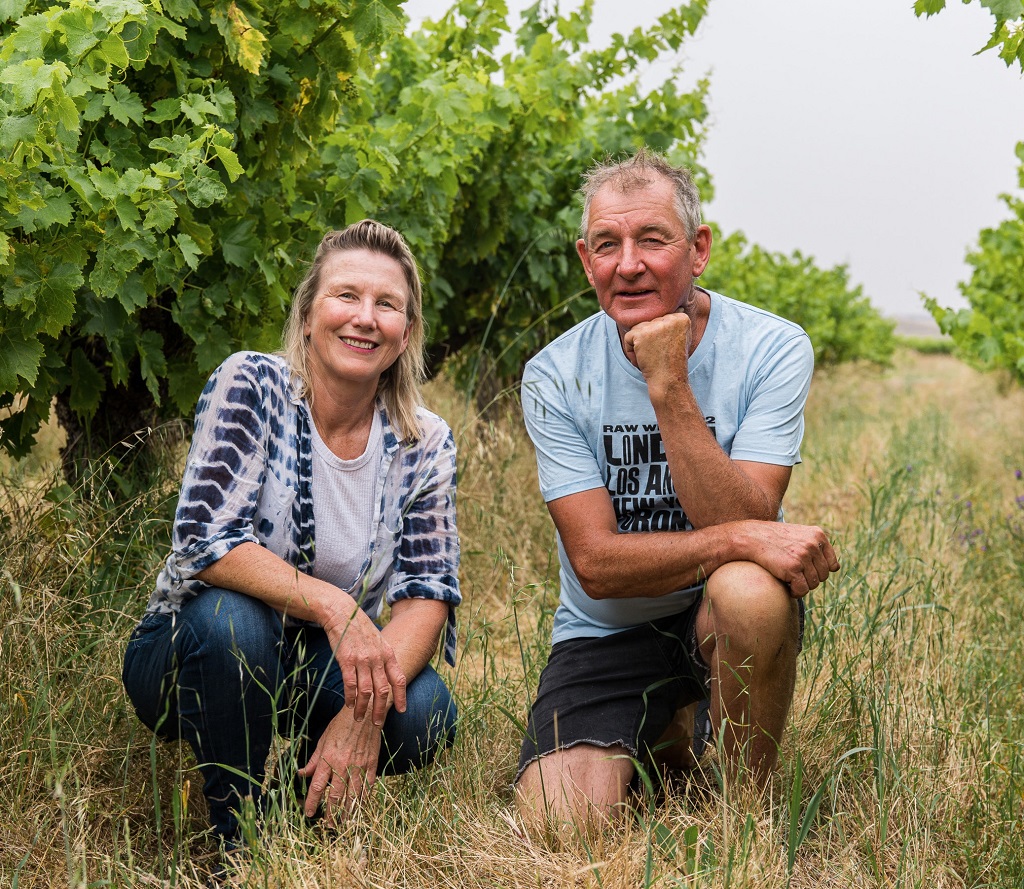
BACKGROUND
The preferred international synonym for this variety is Trousseau (true-so) because DNA evidence suggests an origin in north-east France. Interestingly, both Chenin Blanc and Sauvignon Blanc are siblings of Trousseau; and Savagnin is a likely parent.
The first mention of Trousseau was in Jura (north-east France) in the 18th century as Troussot. It appears to have been taken to the Iberian Peninsula long ago because it has been grown in both Portugal and Spain for at least 200 years. Trousseau has many synonyms including Bastardo and variants (Portugal), Carnaz and Godello Tinto (Galicia Spain), Maria Ordona and variants (Spain) and Maturana Tinta (Rioja, Spain).
The global area planted in 2010 was 3431ha with at least 90% in Portugal, where it is mainly grown in the Douro (as a port variety). In the Jura, where it is a very minor variety today, it is authorised for both Arbois and Cotes du Jura appellations for rosé and red wines. In Australia, Trousseau has had an interesting history. It is likely that it was imported in the 19th century, together with other varieties from Portugal, and was subsequently grown under various names in SA, NSW and Victoria.
When Pierre Truel, the noted French ampelographer, was invited to Australia in 1976 by the CSIRO, he identified old so-called ‘Cabernet Gros’ and ‘Touriga’ vines in mixed plantings in SA and NSW, respectively, as Trousseau. In SA, Francois de Castella (in his report to the Phylloxera Board in 1941 42) stated that ‘Cabernet Gros’ was not a type of Cabernet (as did Boehm and Tulloch 1967).
Until recently, the total area in Australia has been small — there were 26ha in SA in 1999 (Kerridge and Antcliff 1999). Currently, there are at least 10 wine producers in Australia (mainly in SA and WA) with wines labelled as either Bastardo, Trousseau or Maturana Tinta.
VITICULTURE
Budburst and maturity are early. Vigour is moderate with a sprawling growth habit. Bunches are small and well-filled with small berries. Yield can be low to moderate. It is more susceptible to fungal diseases than average, particularly Botrytis bunch rot. Bunches are also prone to sunburn and, as for Shiraz, berries shrivel when ripe.
WINE
Due to a lack of colour, Trousseau is most suited to rosés and light reds if not blended with other varieties. Nevertheless, wines can have fresh acidity and intense fruit with notes of raspberry, spice, and orange peel.
REFERENCES
Boehm, E.W. and Tulloch, H.W. (1967) Grape varieties of South Australia. Adelaide, SA: Department of Agriculture: 95p.
De Castella, F. (1942) The grapes of South Australia: a survey of the viticultural industry, 1941-1942: Francois De Castella’s reports to the Phylloxera Board. Adelaide: Mail Newspapers Ltd: 59p.
Kerridge, G. and Antcliff, A. (1999) Wine grape varieties. Collingwood, Vic.: CSIRO Publishing: 205p.
For further information on this and other emerging varieties, contact Marcel Essling at the AWRI ([email protected] or 08 8313 6600) to arrange the presentation of the Alternative Varieties Research to Practice program in your region.
This article was originally published in the Winter 2023 issue of the Wine & Viticulture Journal. To find out more about our quarterly journal, or to subscribe, click here!
